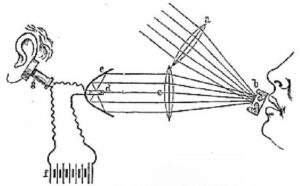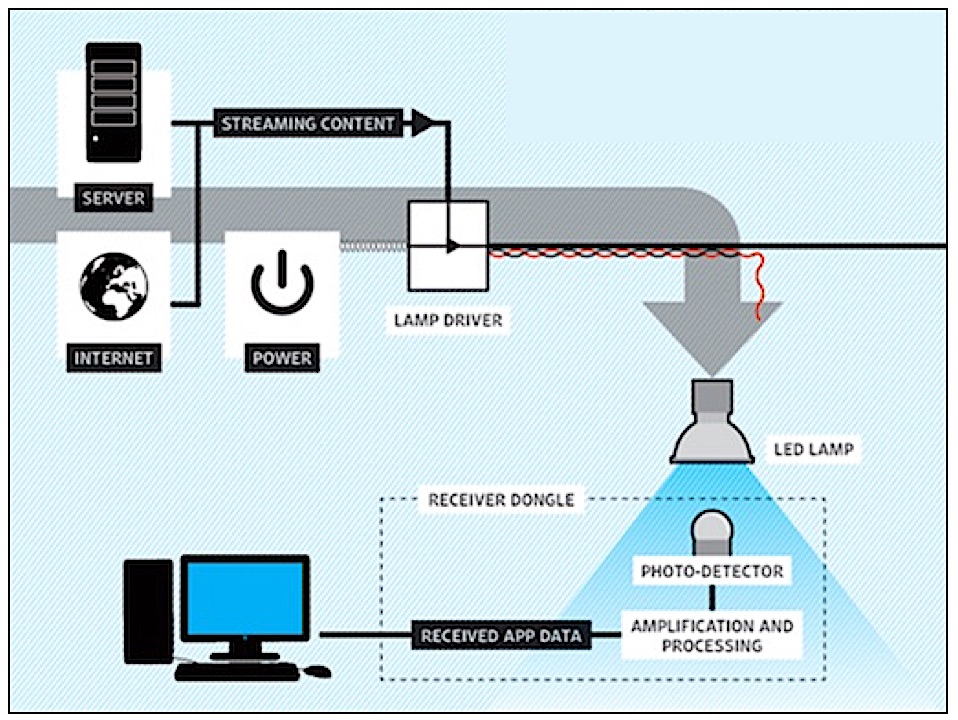Light Fidelity (Li-Fi) and Communication

Christopher Schweizer, Ph.D.
By Christopher Schweizer, Ph.D.
An enduring illustration of a creative ‘bright idea’ is a light bulb suspended over an inspired individual. But to Alexander Graham Bell, the foundational hero of hearing technology, light was much more than an iconic metaphor. It was the future of interpersonal communication, to be called light fidelity (Li-Fi).

Figure 1. Photophone sketch from Bell’s notes of 1880.
Bell and his associate, Charles Tainter, developed the Photophone in their Volta Labs in Washington, D.C. (Figure 1). Although the name may suggest ‘photography,’ this invention really was a prescient method of audio transmission – speech riding on light. It was also wireless telecommunication in the 19th century!
Bell believed his light-operated method of talking across distances was a far more important invention than his original wired telephone. The telephone was, of course, so seminal in stitching the world together into one networked organism as every user of a mobile recognizes when speaking with (or viewing!) family on another continent. The photohone patent, issued in late 1880, predates by many decades’ laser and fiber-optic light-based signal technologies.
However, the prospects for fulfilling Bell’s dream of connecting spoken voices by light has new impetus in this age of emerging green technologies and biomimicry – Hearing Review (2015). An illustrator’s conception of the Bell-Tainter light-based phone is shown in Figure 2.

Figure 2. An illustrator’s conception of the Bell-Tainter light-based phone.
RF, Wi-Fi, and Li-Fi
Radio frequency (RF) waves have been immensely successful as the preferred long distance means of telecommunication, and Wi-Fi provides great convenience in short ranges. But the emergent addition of Li-Fi (Light Fidelity) appears to be an important new player in the earth’s tapestry of inter-connectedness. Light Emitting Diodes (LEDs) are a significant part of the engineering equation since they have a digital aspect (On/Off as in 1/0). They are also notably more ‘green’ in terms of energy use.
Billions of Wi-Fi units are produced every day, so costs for them have been scaled way down for that communication protocol. But the forecast for LED shipments is on a steep growth curve, with 11 million expected by 2018. And while super-fast 5G should become available by 2020, there is a looming ‘spectrum crunch’ – where so much information is crammed into the telecom RF band creating a serious strain on capacity.
The Li-Fi region of the spectrum from near infrared and into visible light (Figure 3) is extremely attractive for a number of reasons, not the least of which it is unregulated. It is also generally more secure; light does not spill through walls and into the trolling nets of hackers. The Wi-Fi region of 2.4 – 5 GHz (increasingly popular with hearing aid connections) is, like the cell tower band, becoming increasingly crowded.
Besides having much more room to operate on the electromagnetic spectrum, Li-Fi also has the favorable prospect for very high speeds of data delivery. While continued improvements might push data rates for Wi-Fi up to 6 or 7 Gigabits Per Second (GPS), Li-Fi has already been operating at hundreds of GPS and theoretically, at least, could reach 3 trillion bits per seconds (TPS)! Figure 3 provides information about the band allocations from 4G to Li-Fi within the electromagnetic spectrum.

Figure 3. Band allocations from 4G to Li-Fi within the electromagnetic spectrum.
The Future – Using Light for Communication?

Figure 4. Multiple access points (APs) throughout an indoor space form an an atto-cellular network, allowing users to move from one AP to the next without any interruption in its high-speed data stream.
While probably not arriving fully at the speed of (dare we say), light there is a notable scramble to investigate the prospects of providing information from every house lamp, traffic light and automobile brake light (informing smart cars of highway data) and more (Figure 4). LEDs can be coded to stream signals by billions of unseen interrupts per second. This opens the possibility for tapping innumerable light sources as communication nodes. Both Philips and Siemens in Europe are testing versions for public spaces, as well as homes.
Sporting events with huge LED displays could allow thousands of attendees to get much better wireless reception via Li-Fi than Wi-Fi. Additionally, it appears possible that LEDs in room lights could be dimmed down when illumination for vision is not needed, but still emit sufficient light for data transmission to mobile devices. Turning off-the-shelf LED light fixtures into wireless access points creates an “atto-cellular” communication system that can serve multiple mobile users at the same time (multi-user access), allowing them to move around inside a room or premises while seamlessly connecting to the best serving light bulb (also termed “handover”).
How Does Li-Fi Work?
An example is illustrated in Figure 5. An overhead lamp fitted with a LED having signal processing technology, streams data embedded in its beam at ultra-high speeds to a photo-detector. A receiver dongle (Figure 6) then converts the tiny changes in amplitude into an electrical signal, which is then converted back into a data stream and transmitted to a computer or mobile device.

Figure 5. Li-Fi combines two essential functions – illumination and communications – this is presumed to provide a cost saving measure that makes more efficient use of existing infrastructure. (Source: PureLiFi)

Figure 6. LiFi-X, the world’s first Li-Fi dongle, as introduced at Mobile World Congress, 2016.
For engineers working in fiber optics and integrated photonics, light as a carrier is not new. But new long distance data connections with lasers have the full enthusiasm of NASA officials at the Advanced Communications and Navigation Division. They express growing excitement about deploying optical modems no larger than cell phones. Tests on the International Space Station are scheduled in the near future.
Editor’s note: As exciting as Li-Fi appears, the future of Li-Fi is not without its distractors, as is just about any new and potentially disruptive technology. One comparison is made to see Li-Fi as being similar to the Smart Home, which has eluded mass-market adoption for over 50 years and still seems as disjointed today as when RCA-Whirlpool demonstrated their Miracle Kitchen at the 1957 World’s Fair. Compare the video of that demo with a similar vision video from CES 2016 at https://mhealthtalk.com/elusive-smart-home/. Some believe that the transition to Li-Fi will likely take many decades because of the need to rewire homes with DC, or just to connect LED drivers to a network (Wayne Caswell comment to Slovick, 2016).
Next week’s post will complete the view of Alexander Graham Bell’s approach to sound transmission via light.
References
Baljko, Jennifer. “A Bright Idea: Using light to transmit data” IHS Electronics360 15 March 2015.
IHS Electronics360 News Desk 03 February 2016.
Jones, Nicola. “Light fantastic” New Scientist 3055 9 January 2016
NASA Engineers Are Transforming Communications with Light-Driven Modems. IHS Electronics360 News Desk 03 February 2016.
Slovick, Murray. Move over Wi-Fi, here comes Li-Fi. HIS Electronics360, 11 March 2016.
Christopher Schweitzer, Ph.D. lectures on Signals, Systems, and Speech at Salus University. He is Chief Technology Counselor for IMHear Corp and Director of Hear4U International.






